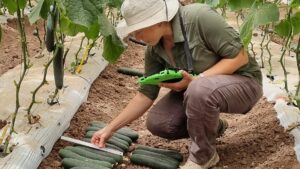While hybridization offers many advantages and has benefited yields in many crop types, it hasn’t made its way into wheat in a big way… yet. It’s not an easy road to get it there.
Despite decades of research and development, hybrid wheat has not yet made significant inroads into North American fields. While some companies are pushing forward on efforts to make hybrid wheat a reality, others are stepping back from hybrid wheat research programs, citing challenges with the crop’s economic viability.
Many growers cultivate major crops using hybrid varieties – seeds obtained by crossing two lines of a crop via artificial pollination. The resulting hybrids offer a wide variety of benefits for growers. Most notably, these benefits include higher yield potential, greater vigor and better ability to withstand various stressors. Those boosts come thanks to heterosis (hybrid vigour), where the growth and yield potential of the hybrid progeny are better than either of the parents.
Hybridization in plants occurs from crossing two distinct lines. In wheat, which has hermaphroditic flowers that self-pollinate, hybridization requires breeders to remove the plant’s natural ability to self-pollinate, then artificially pollinate the flowers with pollen from a separate line. That’s a challenging order for multiple reasons:
Wheat only flowers for a short time, leaving a narrow pollination window. Too, it produces very little pollen compared to other crops. What pollen it does produce is very heavy, making it more difficult to move from male to female plants.
These challenges and others contributed to BASF making the decision to pull its hybrid wheat program from North America in early 2023 after 15 years of research.
“We tried really, really hard,” says Garth Hodges, BASF North American Seed Business vice president, who worked with the hybrid wheat program from the very beginning and was part of the small research team at its inception. “The teams did an incredible job. Over the years, we uncovered many learnings, and we’ve made significant progress with our understanding of hybrid wheat. But despite the tremendous efforts of the expert team, we just could not achieve results that were viable.”
Another limitation to hybrid wheat’s economic viability relates to the male/female ratio of plants during the process of seed production or multiplication. In a conventional wheat seed production, all plants seed is harvested and sold to farmers to plant. However, in hybrid wheat seed production fields, seed producers of hybrid wheat cultivate a small percentage of male plants alongside female plants. The female plants receive pollen from these male plants, while the male plants self-pollinate. Since only seed from female plants is harvested, the seed from male plants – which can make up about 25% of the plant population – is discarded and doesn’t contribute to productivity, making seed production costly.
“The yield difference between your open pollinated varieties and your hybrid has to be pretty big to be able to pay for the fact that you only harvest 75% of the [planted seeds in the] field.” Hodges says.
While BASF is pulling out of hybrid wheat research in North America, it intends to continue its hybrid wheat efforts in Europe. Yields are higher in Europe, so even a slight increase in yields from this hybrid seed may give farmers a practical option.
Not everyone is pessimistic about hybrid wheat’s potential in North America. In fact, Syngenta is ramping up its North American hybrid wheat efforts.
Syngenta is poised to roll out its new wheat hybrid in the United States under the AgriPro brand. Syngenta reports that the hybrid has the potential to increase yields by as much as 15 percent over conventional varieties. Early reports from farmers U.S. Northern Plains region who have had the chance to trial the hybrid through AgriPro are generally positive.
Kevin Capistran of Minnesota-based Capistran Seeds has already been growing the hybrid for a couple of years.
“It’s early in the process yet, but there is a lot of promise,” he says. “When it comes to market potential, there’s been limited acres grown but good interest.”
Dave Hankey of North Dakota-based Hankey Feed Company has sold the wheat hybrid to more than a dozen customers.
“To our customers, we are taking it somewhat slow,” he says. “Results have been a little bit mixed with three-quarter wins. But it’s nice to be on the forefront.”
It’s also nice, he says, that hybrid wheat’s classification as non-GMO will make it an attractive alternative to those resisting the idea of genetically modified technologies.
Growing 150 acres of F1 or offspring himself, Hankey says he’s seen good results, with the male/female blends already performing better than the previous year. He anticipates the crop will see more acres next year, as he’ll be able to offer three times as much seed as in 2023.
Hankey says that, despite the hybrid vigour benefit, pricing will pose a limitation. “There’s a price point where farmers will have resistance, but there’s a risk factor for us growing it that we have to account for.”
Hankey notes that one of the reasons he started growing hybrid wheat is that many wheat acres in his area were being lost to corn. That loss is, at least in part, because corn and soybean technology has advanced faster than wheat. He says he hopes he recent progression in wheat hybridization technology may push wheat one step closer to catching up to the growth and progress of other major crops.
AgriPro’s website states that its hybrid wheat seed will allow farmers to seed more land per pound of seed: the recommended seeding rate is 80% of a typical wheat variety’s seeding rate. Although management practices for growing this hybrid wheat won’t differ much from conventional varieties, producers must sign a hybrid seed stewardship agreement that includes a “no saved seed” clause, requiring them to repurchase new seed every year.
Growing Pains
Because scientists create hybrid wheat seed by planting a combination of male pollinators and non-self-pollinating female plants that open and flower, the chance of ergot infection is exceptionally high. While ergot can be fairly easily cleaned from a harvested crop, it is still a concern that carries additional cost.
Ieuan Evans, AgriTrend forensic plant pathologist, says it’s important to understand hybrid wheat, despite the potential for heterosis, is not a silver bullet that will automatically boost yields. Hybrid wheat might boast a 15-20% return on investment but, if producers want an increase to their bottom line, they should expect to have to increase inputs as well.
“Now, if you want to grow a 50, 60, 70, 80-bushel crop of wheat, you’ve got to balance the fertility to obtain those levels,” Evans says. “More yield means more inputs, more nitrogen, more phosphate.”
Evans says early research in apomixis is another means to move hybrid wheat technology forward. Apomixis — seed production without pollination that produces seeds genetically identical to the mother plant — occurs naturally in several hundred plant species including dandelions and saskatoons. If apomixis could be engineered into hybrid wheat, Evans says it could prove an avenue to reach a large-scale production level.
Hybrid wheat has promise; however, Evans says farmers should prepare to invest in the beginning and be ready to wade through some growing pains. It will take research, trial and persistence for wheat to reach the hybrid crop levels of corn and canola.













